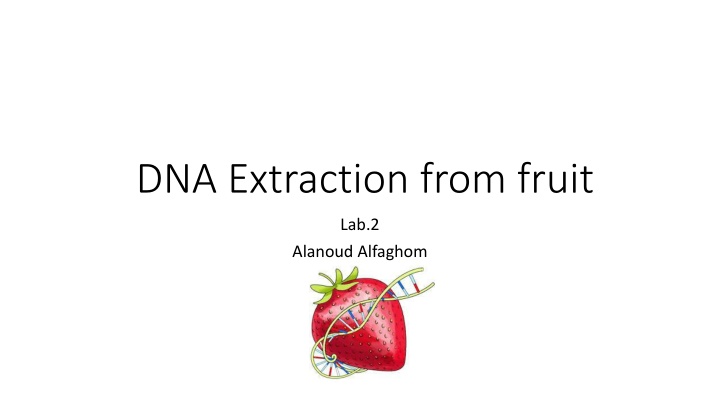DNA Extraction from Fruit Lab: Strawberry Extraction Method
Explore the fascinating process of breaking cell barriers and extracting DNA from strawberry cells. This comprehensive lab guide provides detailed instructions on how to extract DNA using simple materials like strawberries, plastic bags, ethanol, liquid detergent, and more. From mashing the fruit to precipitating DNA strands, follow the step-by-step process to witness DNA extraction firsthand.
Download Presentation

Please find below an Image/Link to download the presentation.
The content on the website is provided AS IS for your information and personal use only. It may not be sold, licensed, or shared on other websites without obtaining consent from the author.If you encounter any issues during the download, it is possible that the publisher has removed the file from their server.
You are allowed to download the files provided on this website for personal or commercial use, subject to the condition that they are used lawfully. All files are the property of their respective owners.
The content on the website is provided AS IS for your information and personal use only. It may not be sold, licensed, or shared on other websites without obtaining consent from the author.
E N D
Presentation Transcript
DNA Extraction from fruit Lab.2 Alanoud Alfaghom
Overview: Understand how cell barriers are broken and how to extract DNA from strawberry cells.
Materials: 50-mL tubes with lids and bases 15-mL tubes with lids resealable plastic bags wooden sticks funnels pack of cheesecloth transfer pipets bottle of ethanol, 95% (100 mL) bottle of liquid detergent 10 g salt (sodium chloride, NaCl)
Method: 1. Obtain one fresh or one frozen and thawed strawberry. If you are using a fresh strawberry, remove the green sepals (tops) from the berry. 2. Place the strawberry in a resealable plastic bag. 3. Close the bag slowly, pushing all of the air out of the bag as you seal it. 4. Being careful not to break the bag, thoroughly mash the strawberry with your hands for two minutes. 5. Pour the 10-mL aliquot of extraction buffer into the bag with the mashed strawberry. Reseal the bag.
6. Mash the strawberry for one additional minute. 7. Place a funnel into a 50-mL centrifuge tube. Fold the cheesecloth in half along the longer side and place it in the funnel to create a filter. The cheesecloth will overlap the edge of the funnel. 8. Pour the strawberry mixture into the funnel, filtering the contents through the cheesecloth and into the 50-mL centrifuge tube. 9. Carefully pour 2 mL of the filtered contents from the 50-mL tube into a clean 15-mL tube. Use the lines on the side of the 15-mL tube to help measure the amount added.
10.Hold the 15-mL tube at an angle. Using a transfer pipet, carefully add 5 mL of cold 95% ethanol by running it down the inside of the tube. Add the 95% ethanol until the total volume is 7 mL (use the lines on the side of the tube to help you measure). You should have two distinct layers. 11.Caution: Do not mix the strawberry extract and the ethanol! 12.Watch closely as translucent strands of DNA begin to clump together where the ethanol layer meets the strawberry extract layer. Tiny bubbles in the ethanol layer will appear where the DNA precipitates. 13.Slowly and carefully rotate the wooden stick in the ethanol directly above the extract layer to wind (or spool ) the DNA. Remove the wooden stick from the tube and observe the DNA .
Break open cells by mashing the fruit Dissolve organelles and cell membranes with detergent. Separate DNA from proteins with salt: Na(+) is attracted to ( )DNA so it bumps off the protein. Filter out the clumps with a cheesclothe DNA precipitates in cold alcohol and is spooled out. Summary























